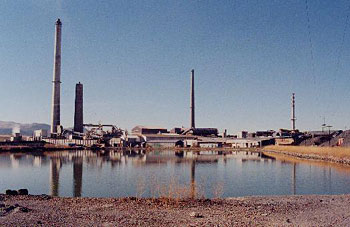Communities exposed to toxic lead emissions recently won an important victory in federal court through a case filed by the Interdisciplinary Environmental Clinic (IEC) at Washington University in St. Louis.
“The court chastised the Environmental Protection Agency (EPA) for long-neglecting its duty to review the lead standard every five years, and placed the agency on a firm schedule for conducting the review,” says Maxine I. Lipeles, IEC director and professor of law and engineering.
“Because the lead standard must be revised to protect public health, and the existing standard is out of date, we believe that the EPA is virtually required to revise the standard downward. That would help protect children in communities across the country where smelters and other facilities emit significant amounts of lead into the air. The decision should also caution the EPA to act more promptly in reviewing the other five national ambient air quality standards * for nitrogen oxides, ozone, sulfur dioxide, carbon monoxide, and particulate matter.”

In the case, filed on behalf of Leslie and Jack Warden, long-time residents of Herculaneum, Missouri, and the Missouri Coalition for the Environment, U.S. District Judge E. Richard Webber ruled:
• The EPA “blatantly disregarded Congress’ mandate that the lead NAAQS [National Ambient Air Quality Standard] be reviewed at five year intervals.”
• The EPA’s proposed timeline for completing its review of the lead NAAQS is too long, and “wholly defeats the mandate of Congress.”
• The EPA must complete the lead NAAQS review by Sept. 1, 2008. Their progress will be monitored through a series of interim deadlines beginning Dec. 1, 2005. “The Court will not be inclined to grant extensions.”
• The “Plaintiffs are entitled to reasonable attorney fees.”
“The EPA commenced the lead NAAQS review last November, after the Clinic filed the lawsuit,” Lipeles says. “The agency will now have to expedite its schedule to meet the Court’s tighter deadlines.”
The Court’s ruling is particularly significant to the community of Herculaneum, Missouri, where the nation’s largest lead smelter has been operating since the 1890’s.
“A substantial percentage of the Herculaneum children have been lead poisoned, and many yards and streets have been contaminated,” Lipeles says. “Although the air in Herculaneum finally came into compliance with the outdated lead NAAQS in late 2002, yards and streets that were previously cleaned are predicted to be recontaminated within the next 3-4 years.
Lipeles says that the IEC’s work on this case reflected an interdisciplinary approach.
“Students from the schools of Medicine, Law, Engineering, and Arts & Sciences at Washington University in St. Louis worked on interdisciplinary teams, supervised by faculty with legal, engineering, and medical expertise,” she says.
“Together they determined that the existing standard was no longer protective of human health; that the EPA was legally obligated and could be compelled to review the outdated standard; and that the results could benefit our clients as well as other affected communities around the country,” Lipeles says. “The students presented their results to our clients, prepared all of the documents necessary to pursue the litigation, and the law students formally appeared in federal court hearings in the case. The clients were delighted to have access to technical expertise and legal representation that they could not otherwise afford.”
The EPA initially set the governing lead NAAQS in 1978, and has never revised it.
“During the intervening years, the federal threshold for lead poisoning has dropped dramatically, and the World Health Organization published a substantially more protective standard for Europe,” Lipeles says.